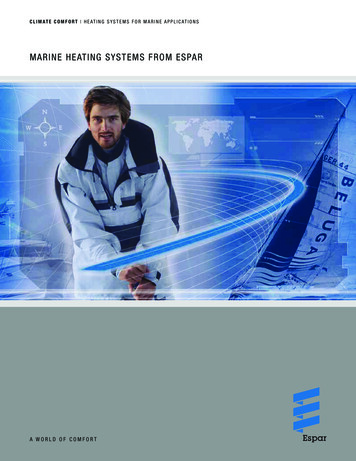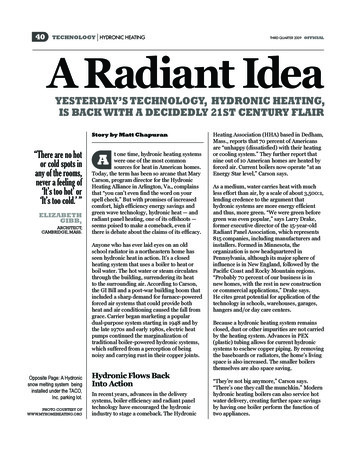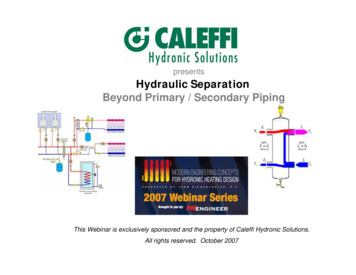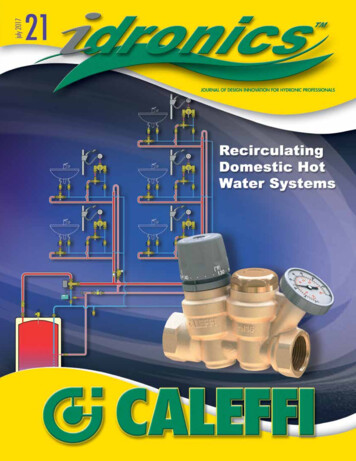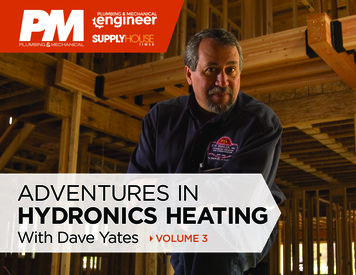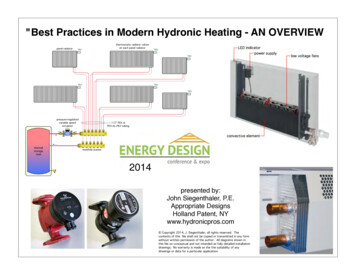
Transcription
"Best Practices in Modern Hydronic Heating - AN OVERVIEWpanel radiatorthermostatic radiator valves!on each panel ble speedcirculatorthermalstoragetank1/2" PEX orPEX-AL-PEX tubingmanifold station2014presented by:John Siegenthaler, P.E.Appropriate DesignsHolland Patent, NYwww.hydronicpros.com Copyright 2014, J. Siegenthaler, all rights reserved. Thecontents of this file shall not be copied or transmitted in any formwithout written permission of the author. All diagrams shown inthis file on conceptual and not intended as fully detailed installationdrawings. No warranty is made as the the suitability of anydrawings or data for a particular application.
"Best Practices in Modern Hydronic Heating - AN OVERVIEWThis Morning’s topics. Why hydronics High efficiency gas-fired boilers Low temperature heat emitter options High efficiency circulators Homerun distribution systems Zoning options
What are the advantages of using hydronic heating in these houses?Water vs. air:Itʼs hardly fair.
Water is vastly superior to air for conveying heat2 x 12 joistthis cut would destroy the load-carryingability of the floor joists3/4" tube14" x 8" ductA given volume of water canabsorb almost 3500 times asmuch heat as the samevolume of air, when bothundergo the sametemperature change
High efficiency gas-fired boilersHydronic heat source boilersRENEWABLE HEAT pumpsvaporcomp.pellet-firedboilersConventional boilers are not intended tooperate with sustained flue gascondensation. Allowing them to operatewith such condensation will damage boththe boiler and waterwater-to-water(geothermal)air-to-water
steeatmosConventional boilersConventional boilers are not intended to operatewith sustained flue gas condensationgas-firedcopper water tubeatmospheric draftoil-firedsteel fire tubeatmospheric draftoil-firedcast-iron sectionalatmospheric draftgas-firedcast-iron sectionalatmospheric draft
steeatmosConventional boilers“EVERY BOILER can be a condensing boiler.”For conventional gasfired boilers,sustained inlet watertemperatures of 130ºF or more arerecommended toprevent sustained fluegas condensation.
steeatmosConventional boilersThe system must be designed to maintain the boiler inlettemperature above dewpoint of flue gases.mixed supplytemperature!sensorVENTmixing!assemblyboiler loopdistributionsystemboiler inlettemperature!sensorconventionalboilerThe only way to ensure that a conventional boiler is protected againstsustained flue gas condensation is to measure boiler inlet temperatureand provide a mixing assembly that reacts to this temperature.
steeatmosConventional boilersProtecting conventional boilers from sustained flue gas condensationAn intelligent mixing assembly that can sense boiler inlet watertemperature and react to it WILL protect the boiler from sustained flue gascondensation.bypass flow through! 14.5 gpm!closely spaced tees 135.4 ºF50,000 Btu/hr!heat output ratemixing valve!controller !set for 125ºF135.4 ºF!20 gpm135.4 ºF!2.39 gpm93 ºF!2.39 gpm111.4 ºF!5.5 gpm93 ºF3.11gpm93 ºF!5.5 gpm135.4 ºFbypass!circulator T 5.1ºF130 ºFdewpoint130 ºF!20 gpm130 ºF6 floor circuits!300 ft x 1/2" PEX!12" spacing bare slabboiler inlettemperature sensor50,000 Btu/hr!heat input rate!to waterthermal equilibriumThe only way to ensure that a conventional boiler is protected againstsustained flue gas condensation is to measure boiler inlet temperatureand provide a mixing assembly that reacts to this temperature.
steeatmosHigh efficiency gas-fired boilersMod/con (e.g., modulating / condensing) boilers are built withthe intent that fluid gases will condense within the boiler.These boilers use stainless steel or aluminum heatexchangers that can withstand the corrosive nature ofcondensed flue gases. (pH 4.0)Mod/con boilers use a variable speedcombustion air blower andproportional gas valve to regulate therate of combustion. Typical range ofmodulation (20 - 100%). Wall hung Free standing on floor Sealed combustion Requires condensate drain
steeatmosHigh efficiency gas-fired boilersmodulating / condensing boilers, plenty to choose from.These are all “low mass” mod/con boilers
steeatmosHigh efficiency gas-fired boilersmodulating / condensing combi-units (space heat AARSTriangleTubeDesigned for “on-demand” DHW.30-45 seconds from cold start torated DHW delivery s steel!brazed plate!heat exchangerto / from!space!heatingmotorized!diverter!valve
steeatmosHigh efficiency gas-fired boilersTo prevent short cycling - these boilers are often installedwith a buffer tank.temperature!sensorbuffer tankto / from!heating loadmod/con boiler!(low mass)
High efficiency gas-fired boilersHIGH THERMAL MASS mod/con heating appliances “Self-buffering” heatsource. No buffertank required. Low pressure drop no separate circulatorrequiredHTP, Inc “Pioneer” heating appliance
High efficiency gas-fired boilersadd on DHW module to create combi-unit
High efficiency gas-fired boilersEuropean approach to combinedspace heating & DHWpanel radiatorAPPLIANCE!for space heating!and DHWRotexACVDHWcoldTRV
High efficiency gas-fired boilersEuropean approach to combinedspace heating & DHWDo you notice anything in common amongthese products? None of them look like a boiler or water heater. They all look like an “appliance.” They all have sufficient water volume tostabilize against short cycling the burnerunder light loading.This iswhatsomeNorthAmericansystemslook like.
High efficiency gas-fired boilersSolar assisted space heating & DHW, high mass mod/con
steeatmosHigh efficiency gas-fired boilersLOW WATER TEMPERATURE ARE CRUCIAL TO HIGH PERFORMANCEDESIGN ISSUE: To obtain highefficiency ( 88 to 97%), the watertemperature supplied to the mod/con boiler must be lower than thedewpoint of the exhaust gases.Condensing mode operationbegins at inlet water temperaturesof about 130 ºF, andcorresponding thermal efficiencyof about 87.5%.Thermal efficiency climbs as inletwater temperature decreases.Inlet water temperature is afunction of system design.Applying mod/con boilers inhigher temperature systems isgenerally not recommended.
steeatmosHigh efficiency gas-fired boilersMany mod/con boilers have compact heat exchangers:Whatʼs good about this: Very low metal and water content.Whatʼs bad about this: Very low metal and water content.DESIGN ISSUE: Low thermal mass boilers combined withhighly zoned distribution systems will cause “short cycling.”TYPICAL SOLUTION: add thermalmass in the form of a buffer tank.heatingload(Btu/hr)heating load profileon at 30%, then stabilizeramp down100%hold at 20%, then off20%10%time (hr)minimum modulation 20% of full outputheat source must cycle on/off to supply loads!under 20% of full output
steeatmosConventional boilersDESIGN ISSUE: The very low pressure drop associatedwith cast-iron sectional boilers, and most fire tube boilersallows full system flow to pass through boiler.100,000 Btu/hr !compact mod/con100,000 Btu/hr !cast-iron sectional25pressure drop (psi)2015105VENT002468flow rate (gpm)1012conventional boiler!with low flow resistance
steeatmosHigh efficiency gas-fired boilersMany compact modulating / condensing boilers create high pressure dropDESIGN ISSUE: Compact boiler heatexchangers also create significantly higherpressure drop as fluid flows through them.cast-ironsectional boiler20pressure drop (psi)TYPICAL SOLUTION: Use a dedicatedboiler circulator to create flow throughboiler, in combination with some formof hydraulic separation.100,000 Btu/hr !compact mod/con100,000 Btu/hr !cast-iron sectional2515105compactmod/conheat exchanger002468flow rate (gpm)1012
steeatmosHigh efficiency gas-fired boilersDESIGN ISSUE: Compact boilerheat exchangers also createsignificantly higher pressure dropas fluid flows through them.high flow !resistance boilerHydraulic separationusing closely spaced tees.TYPICAL SOLUTION: Use adedicated boiler circulator tocreate flow through boiler, incombination with some form ofhydraulic separation.closely spaced teessize headers for maxflow velocity of 2 ft/secvery low flow resistance!common piping!
steeatmosHigh efficiency gas-fired boilersDESIGN ISSUE:Compact boiler heatexchangers also createsignificantly higherpressure drop as fluidflows through them.high flowresistanceboilerTYPICAL SOLUTION:Use a dedicatedboiler!boiler circulator tocirculatorcreate flow throughboiler, in combinationwith some form ofhydraulic separation.buffer!tanksize headers formax flow velocity of2 ft/secvery low flow resistance!common piping!Hydraulic separationusing buffer tank.
steeatmosHigh efficiency gas-fired boilersDESIGN ISSUE:Compact boiler heatexchangers also createsignificantly higherpressure drop as fluidflows through them.high flow !resistance boilerTYPICAL SOLUTION:Use a dedicatedboiler circulator tocreate flow throughboiler, in combinationwith some form ofhydraulic separation.hydraulic separatorsize headers for maxflow velocity of 2 ft/secHydraulic separationusing hydraulic separator.very low flow resistance!common piping!
arrayctorcolleinitial lift headsolartemperature sensor mounted toabsorber plate, or well within collectormodulating /condensingboilerair return tubeair return tubedrainback /!expansion spaceDHWthermal!storage!tankSolar combisystemwith drainback freezeprotectionTop of tankmaintained atminimum of 120 ºFoutdoor!temperature!sensormanifold valve actuatorszoned radiant ceiling panelspressure regulated!variable speed circulator3-way motorized mixing valve!(provides outdoor reset control)variable speed!collector circulator
Low temperature /low masshydronicheat emitters
Low temperature / low mass hydronic heat emitters
Heat sources such as condensing boilers, geothermal & ATW heat pumps,and solar collectors all benefit from low water temperature operation.Coefficient Of Performance ering water temperature (ºF)125leaving load water temp 86 ºFleaving load water temp 104 ºF0.86.50.760.65.550.5COPthermal efficiency (decimal %)leaving load water temp 122 ºF0.40.34.543.50.2ambient air temp. 30ºF!solar radiation 250 Btu/hr/ft2)0.106080100 120 140 160 180 200inlet fluid temperature (ºF)32.52-10010 20 30 40 50 60Outdoor air temperature (ºF)70
Is radiant floor heating always the answer?“Barefoot friendly”floors.
Is radiant floor heating always the answer?Consider a 2,000 square foot well insulated home with a design heat loss of18,000 Btu/hr. Assume that 90 percent of the floor area in this house isheated (1800 square feet). The required upward heat flux from the floor atdesign load conditions is:heat flux design load 18,000 Btu/hrBtu 10floor area 1,800 square feethr ft 2Tf average floor surface temperature (ºF)Tr room air temperature (ºF)q heat flux (Btu/hr/ft2)To deliver 10 Btu/hr/ft2 the floor only hasto exceed the room temperature by 5degrees F. Thus, for a room at 68 degreesF the average floor surface temperature isonly about 73 degrees F.This is not going to deliver "barefootfriendly floors" - as so many ads forfloor heating promote.?
Why radiant floor heating ISN'T always the best choice Direct gain passive solar buildings Initial concept: Since the insulated floorslab is already there- why not add tubingto keep it warm on cloudy days?The passive solar concept relies on thefloor mass giving up it’s heat at night.If maintained at an elevated temperature withauxiliary heat ensuing solar gains cannot beabsorbed.The space quickly overheats.
A comparison of THERMAL MASS for several heat emitters:All heat emitters sized to provide 1000 Btu/hr at 110 ºF average watertemperature, and 70 ºF room temperature:
Low thermal mass allows the heat emitters to quickly respond tochanging internal loadsNotice where the tubing is inthis 6” heated concrete slab
Donʼt do this with ANY hydronic heat source!Heat transfer between the water and the upper floor surface is severely restricted!
the boiler and flue. High efficiency gas-fired boilers Hydronic heat source options. gas-fired cast-iron sectional atmospheric draft oil-fired cast-iron sectional . leaving load water temp 122 ºF Heat sources such as condensing boilers, geothermal & ATW heat pumps, and solar collectors all benefit from low water temperature operation .

